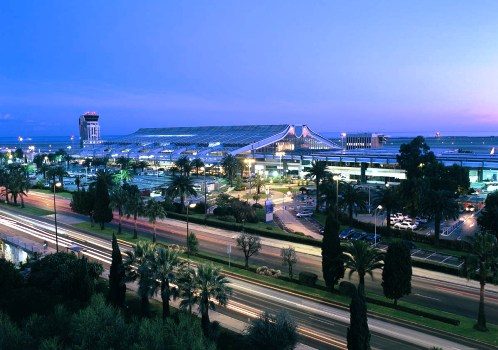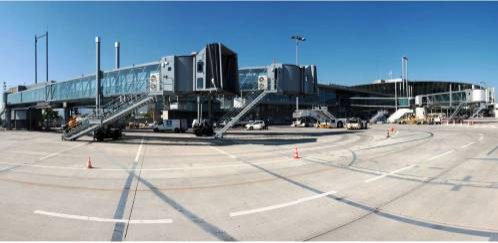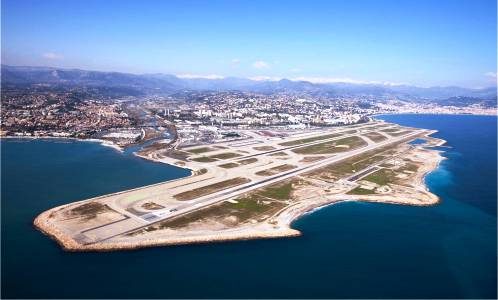It serves one of Europe’s most-visited regions. It experiences high traffic levels throughout the year. It offers high quality services and infrastructure, guaranteeing genuinely high levels of economic performance for companies. No doubt about it: Nice Côte d’Azur Airport is one of European air travel's gilt-edged securities.
The Spring-Summer 2011 programme was in every respect a remarkable one for Nice Côte d’Azur airport. With its unprecedented network of 105 scheduled destinations served by 59 operators, France's second airport saw exceptional levels of traffic with over 2.3 million passengers in July and August alone. That translates into a load factor of 80.2 per cent. A record! And, at this rate, the ten million passengers in a year mark should be crossed within the next few weeks.
 Nice Côte d’Azur airport is in surprisingly good health in these economically difficult times. This, however, owes nothing to chance. On the contrary, it's built upon solid foundations: an attractive destination, modern infrastructure, highly efficient teams of employees. A cocktail that guarantees optimum operating conditions for air travel companies.
Nice Côte d’Azur airport is in surprisingly good health in these economically difficult times. This, however, owes nothing to chance. On the contrary, it's built upon solid foundations: an attractive destination, modern infrastructure, highly efficient teams of employees. A cocktail that guarantees optimum operating conditions for air travel companies.
This isn't a new phenomenon. For almost two hundred years the entire world has been meeting on the French Riviera. But although this destination of dreams, washed by the Mediterranean and caressed by constant sunshine, has long been the preserve of crowned heads and stars, it has opened up to new groups of visitors over the last two decades. Currently, over ten million tourists visit the region every year. And contrary to the generally accepted perception, the majority of these come to visit "out of season". The sea, the blue sky and the beaches are no longer the only assets that the Riviera possesses. Many other centres of interest have been developed.
With 150 different sites and monuments, noted establishments like the Fondation Maeght and the Chagall, Matisse, Picasso, Cocteau or Bonnard museums, and with events as popular as the Cannes Festival or the Nice or Menton Carnivals, the Côte d’Azur is today a globally recognised region of culture. This is reflected by the fact that over a million visitors name cultural motivation as their prime reason for visiting the Côte d’Azur.
 Besides culture, there's sport. People watch it: each time the Monaco Grand Prix is run it attracts tens of thousands of fans. People also take part: every year the Nice hinterland attracts increasing numbers of visitors who enjoy trekking, canyoning, rafting and, increasingly, winter sports. An hour's drive from the Promenade des Anglais, the Alpes d'Azur offer high-quality ski-slopes for skiers and boarders of every level. Isola 2000 has even held the French snowfall record for the last few winters!
Besides culture, there's sport. People watch it: each time the Monaco Grand Prix is run it attracts tens of thousands of fans. People also take part: every year the Nice hinterland attracts increasing numbers of visitors who enjoy trekking, canyoning, rafting and, increasingly, winter sports. An hour's drive from the Promenade des Anglais, the Alpes d'Azur offer high-quality ski-slopes for skiers and boarders of every level. Isola 2000 has even held the French snowfall record for the last few winters!
A final selling point for local tourism is the business sector, being second only to Paris in this field, in France. It must be said that it attracts thousands of events every year: incentives, seminars, exhibitions and conferences. This is a source of income which is all the more welcome to those involved in tourism since these are, for the most part, recurring events. The particularly high-quality infrastructure which includes, for example the Palais des Festivals at Cannes or the Grimaldi Forum in Monaco, has meant that many exhibitions are loyal visitors to the Côte d’Azur (for example MIPCOM, MIPIM, Marché du Film, Tax Free ).
Although two million business visitors come to the Alpes-Maritimes and Monaco each year, not all of these attend events. Many come here simply for business meetings. The local economy is in good health. Its strength lies, in particular, in the many centres of excellence. The largest employer in the département with its Centre Spatial de Cannes Mandelieu, Thalès Alenia Space is a major player in the world’s aerospace industry. Led by giants such as Mane and Robertet, the Grasse-based aroma and perfume industry is an acknowledged world leader. The know-how of Monaco-based financiers in the Private Banking sector is also internationally recognised. As for the Sophia-Antipolis Technopole, with its 1,400 specialist high-tech and life-science businesses (which include Amadeus, Bayer, Accenture, Toyota etc.); it remains the most attractive "corporate" shop window on the French Riviera!
 Air transport is of one of the biggest beneficiaries of tourism and this economic dynamism. Around 25 per cent of Côte d’Azur tourists actually choose to travel by air, and large numbers of local residents, whether travelling for personal or business reasons, also prefer to travel by plane.
Air transport is of one of the biggest beneficiaries of tourism and this economic dynamism. Around 25 per cent of Côte d’Azur tourists actually choose to travel by air, and large numbers of local residents, whether travelling for personal or business reasons, also prefer to travel by plane.
Routes such as Nice - Paris or Nice - London are therefore amongst the most heavily used in Europe. The region is one of the major gaps in the high speed train network, and as a result Nice is still more than two hours from Marseille by train and more than five hours from Paris, whilst the flight to the Capital takes barely an hour! Flying is especially favoured by tourists since it drops them off at the entrance to the city. Fully integrated within the greater Nice conurbation, the airport is five minutes from Place Massena, at the heart of Nice. The steps of the Palais des Festivals at Cannes and the ramparts of the Prince's Palace at Monaco are also less than half an hour away by road.
Air routes to Nice are, therefore, profitable for the great majority of airlines who use them. This is especially so since the Nice Côte d’Azur airport has put in place various services to further improve this profitability. Its staff and infrastructure provide the optimum conditions for operations and turnaround. Its Freight terminal also makes a contribution to economic performance on many routes - goods transport often represents at least ten per cent of income for medium-haul routes. Its impact on transport operators' finances is even greater for transcontinental flights, and may reach 20 per cent of turnover for certain connections. All this, of course, explains the success of the Nice platform with companies from all over the world, both low-cost and legacy. But, the greatest success experienced by France's second airport isn't so much that it has attracted carriers, but that it has then been able to keep them. Air France, Emirates Airline, Delta Air Lines or Lufthansa flights have landed there daily for many years. It's also one of easyJet's historical destinations, and far from fading over time, the Côte d’Azur's appeal for this British company continues to grow just announcing the creation of a base at the airport in spring 2012. And, Air France is to expand too, hoping to make the tarmac at Nice one of the pivots of its new provincial organisation.
All this, of course, explains the success of the Nice platform with companies from all over the world, both low-cost and legacy. But, the greatest success experienced by France's second airport isn't so much that it has attracted carriers, but that it has then been able to keep them. Air France, Emirates Airline, Delta Air Lines or Lufthansa flights have landed there daily for many years. It's also one of easyJet's historical destinations, and far from fading over time, the Côte d’Azur's appeal for this British company continues to grow just announcing the creation of a base at the airport in spring 2012. And, Air France is to expand too, hoping to make the tarmac at Nice one of the pivots of its new provincial organisation.
And who knows? There may be other good news in the pipeline in the future, such as the possible arrival of an Asian carrier. This is something the airport management has pushing hard for over the past few years and they are hopeful of achieving in the not to distant future. They even have resources ready for such a service with the inauguration of the Passerelle 54 boarding bridge. This new station allows contact boarding with the double deck of the A380, the giant of the airways. Apart from Paris, no other airport in France can currently offer equivalent infrastructure, an investment which speaks volumes for Nice's ambitions.





